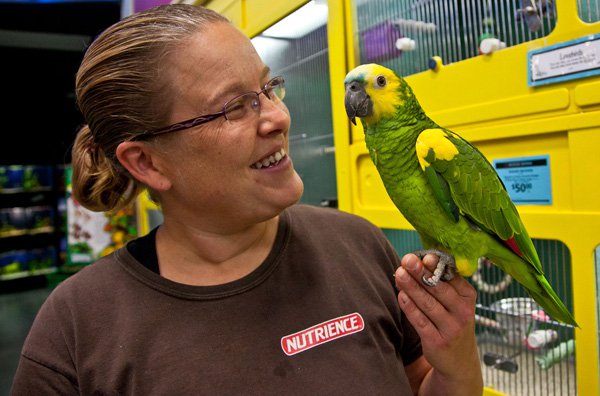
Osteosarcoma is the most common type of bone cancer in dogs.
This cancer most often affects large, middle-aged dogs weighing
more than 40 pounds. Osteosarcoma can occur in any bone (e.g.,
rib, skull, toe) but the most common sites are the ends of leg
bones, especially at the wrist, shoulder, knee, and hip. The
causes of osteosarcoma are unknown, but genetics and microscopic
injury to the ends of the bone during growth play a role.
Osteosarcoma begins in the bone but spreads to the lungs and
other organs early in the course of disease, even before the
initial cancer in the bone is detected. This spread of cancer is
called metastasis. In 5 per cent of dogs with osteosarcoma,
these metastases are visible on a chest x-ray when the dog is
first brought in for the bone cancer.
In over 90 per cent of the dogs with osteosarcoma, these
metastases are present but are too small to be seen on the
initial x-ray. They are termed “micrometastases.”
The first sign of ostcosarcoma is generally lameness caused by
pain from the cancer. The lameness may come and go and vary in
severity from dog to dog. In some dogs the leg may fracture at
the cancer site. As the cancer grows, a swelling at the site
will also develop, which you may be able to feel or see.
X-rays are the first step in identifying bone cancer. X-rays can
only suggest the diagnosis on the basis of the appearance of the
bone. X-rays of the chest are also recommended to search for
metastases.
Biopsy of the abnormal bone is the only way to diagnose bone
cancer absolutely. Side effects of biopsy can include pain,
bleeding, and, rarely, fracture of the diseased bone. In 10 to
20 per cent of cases, biopsy may fail to diagnose the cancer, so
negative results should be evaluated carefully.
Osteosarcoma is a very aggressive form of cancer in dogs.
Oncologists (cancer treatment specialists) have not found a
cure. Treatment of both the cancer in the bone and the
metastases, however, can give many dogs months to years of
good-quality life.
Amputation and chemotherapy are the ideal treatment for dogs
with osteosarcoma. The amputation removes the primary cancer and
also relieves the bone pain. Most dogs are walking the day after
amputation and running soon after. Three-legged dogs have been
known to herd cattle and compete in field trials and generally
enjoy the same activities as four-legged dogs.
The chemotherapy slows down but does not eliminate the
metastases.
The chemotherapy currently recommended by most oncologists is
usually given once every 3 weeks for four treatments. Most dogs
tolerate chemotherapy well and experience only a day or two of
mild lethargy or decreased appetite after each treatment.
Potentially serious side effects after chemotherapy are uncommon
but can include poor to no appetite, vomiting, diarrhea, blood
infection, kidney damage, or heart damage. With amputation and
chemotherapy, 50 per cent of dogs are alive at 12 months and 15
to 20 per cent are alive at 2 years. Almost all dogs eventually
die from osteosarcoma.
Amputation without chemotherapy provides only pain relief. The
metastases continue to grow until they cause death. Only fifty
per cent of dogs are alive 4 months after amputation alone and 5
to 10 per cent are alive at 1 year.
In rare cases, amputation may not be advised by your
veterinarian.
Dogs with preexisting disease in other legs or severe obesity
may not do well after amputation. One option for these dogs is
limb-sparing surgery instead of amputation. This is generally
possible only when the cancer is in the front limb in the bone
called the radius. With this procedure, the cancerous bone is
removed, replaced with bone from a dead dog, and the wrist joint
is fused so that it cannot bend. Recovery takes 1 to 2 months
and infections are common. Survival times are the same as for
amputation.
For dogs unable to benefit from surgery at all, radiation
therapy may be offered as a treatment to relieve pain. Radiation
is given over a 3-week period and reduces but does not eliminate
pain in about 30 per cent of dogs. The improvement lasts for
about 4 to 5 months in these dogs. This therapy increases the
likelihood that a dog will break the limb at the cancer site.
Dogs who do not receive any therapy for osteosarcoma are in pain
and have a poor quality of life. This pain continues to progress
and, according to people with bone cancer, is severe and
uncontrollable. Common painkillers do not work. Euthanasia is
generally the only humane choice.
The above is general veterinary information. Do not begin
any course of treatment without consulting your regular
veterinarian. All animals should be examined at least once every
12 months.
 Yorkshire Terriers And Hypoglycemia
Yorkshire Terrier
Yorkshire Terriers And Hypoglycemia
Yorkshire Terrier
 6 Myths About Dog Behaviours Debunked
6 Myths About Dog
6 Myths About Dog Behaviours Debunked
6 Myths About Dog
 Complete sinking water food spirulina wafers best for aquarium fishes
Complete sinking water food spirulina wafers best for aqua
Complete sinking water food spirulina wafers best for aquarium fishes
Complete sinking water food spirulina wafers best for aqua
 Veterinary Malpractice - What You Can Do About It
Veterinary Malpra
Veterinary Malpractice - What You Can Do About It
Veterinary Malpra
 Common Illnesses In Cockatiels
Common Illnesses
Common Illnesses In Cockatiels
Common Illnesses
Copyright © 2005-2016 Pet Information All Rights Reserved
Contact us: www162date@outlook.com